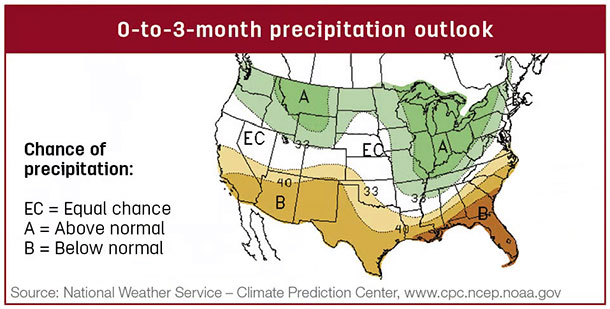In southern Oklahoma and northern Texas, the excessive rainfall in August made it difficult to harvest good-quality hay. Hay fields were cut and rained on before baling, and grass was very mature by the time it was dry enough to cut.
So what happens to hay that has been cut and rained on before baling? Rain affects dry matter yield and quality. With grasses, rainfall affects leaching of soluble nutrients, plant respiration and color bleaching. Leaching is when water-soluble nutrients (such as carbohydrates, soluble nitrogen, minerals and lipids) in the plant cells separate out.
The term soluble refers to components that are easily digestible by livestock. When these nutrients are leached out, we lose dry matter yield which affects the quality of our hay. For example, total digestible nutrients (TDN) and digestibility in dry hay will decrease depending on the amount of rainfall it received while curing. This can affect the energy value and digestibility of the hay.

During late summer, excessive rainfall prevented producers from cutting their hay at the right stage of maturity. As we know, stage of maturity at harvest is the most important factor determining forage quality. With advancing maturity comes a decline in forage quality.
Because producers in our region dealt with both of these factors this year, most of the hay we are feeding may not meet the needs of a spring-calving cow in late gestation or a fall-calving cow. If you don’t know the quality of your hay, you may not realize your cows are losing body condition until it is too late to correct that condition loss before calving this time of year.
To give you an example of the impacts of hay quality on change in body condition and cow body weight gain, to change a cow during the last three months of pregnancy from a body condition score (BCS) of 4 to 5 by calving, she needs to gain approximately 140 pounds (1.56 pounds per head per day).
Of the 140 pounds, 90 pounds equals 1 BCS change; the rest is the growth of the fetus (the fetus grows approximately 67 percent of its weight during the last three months of gestation).
With this scenario, if we are feeding hay that is poor-quality (TDN equals 52 percent), average-quality (TDN equals 58 percent) or above-average quality (TDN equals 62 percent), a cow would barely maintain body condition with poor-quality hay.
She would take 77 days to gain 1 BCS with average-quality hay and 40 days to gain 1 BCS with above-average-quality hay. This gives you an example of how difficult it is to put body condition on a late-gestating cow, especially the closer to calving you are. So get your hay tested. ![]()

-
Ryon S. Walker
- Livestock Consultant
- Noble Research Institute
- Email Ryon S. Walker







